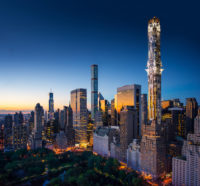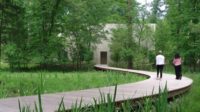In the middle of the desert in Qatar, four enormous steel plates rise from the bleak landscape, oriented along an east-west axis over a half-mile stretch. The monolithic structures comprise Richard Serra’s sculpture East-West/West-East—the artist’s second public commission from the Qatar Museums Authority. Several years ago, while in Doha for the first commission (the 80-foot-high sculpture 7, which stands in the city’s harbor near the I. M. Pei-designed Museum of Islamic Art), Serra visited the Brouq Nature Reserve. “I was drawn to that desert because of its topography,” he says. “The site is rugged and craggy, with shell underfoot, very arid and windy.” He noted the distinctive gypsum plateaus, “shaped like oversized mushrooms,” which, at around 50 feet high, defined East-West/West-East’s scale. Informed by the site’s incline, the installation’s four imposing pieces vary in height from 48 to 55 feet, level with the tops of the plateaus. Initially bluish-gray in color, the half-inch-thick plates will develop a patina as they oxidize and weather, transitioning to orange, brown, and finally a dark brown-black. “Working in the desert is something I hadn’t thought I’d do,” says Serra, “and it ended up being one of the better experiences of my life. I’d never spent that much time in that vast a space, and there’s something very humbling about it.”










Post a comment to this article
Report Abusive Comment